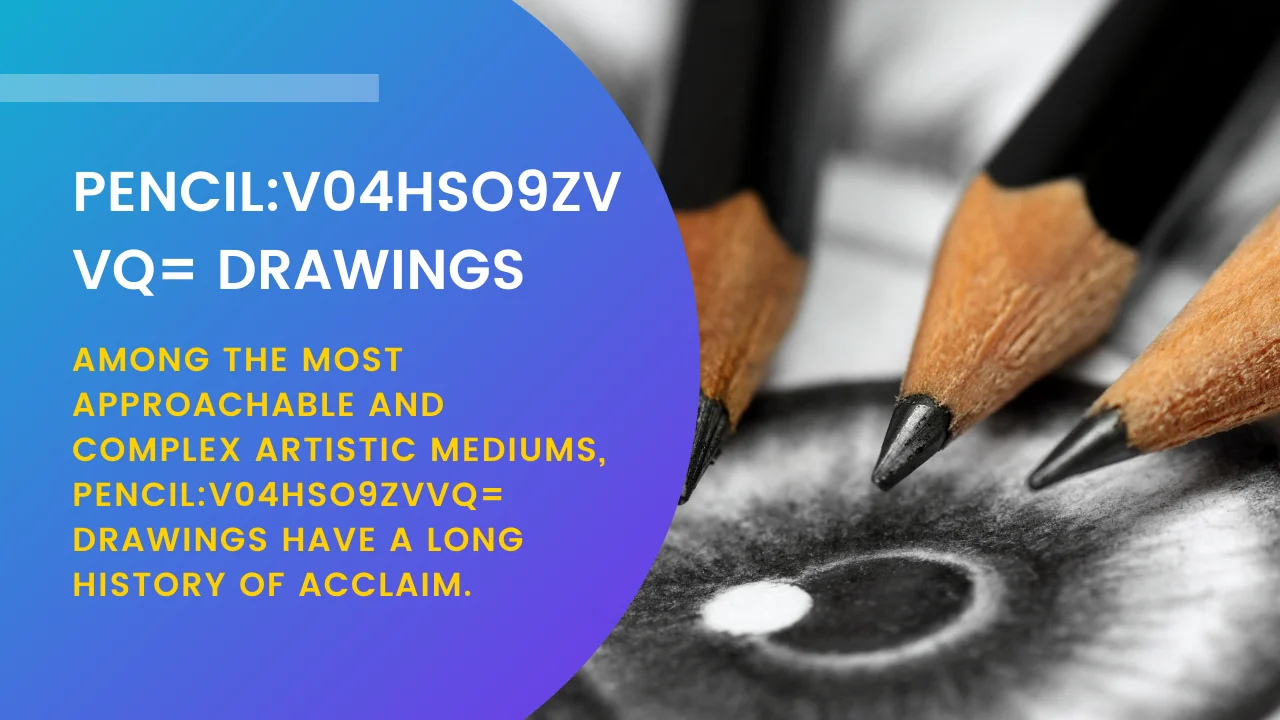Among the most approachable and complex artistic mediums, Pencil:v04hso9zvvq= Drawings have a long history of acclaim. A simple pencil and paper can allow artists to express complex ideas, realistic portraits, or even feelings. Because of their adaptability and ease of use, Pencil:v04hso9zvvq= Drawings are a great medium for artists of all skill levels to express themselves. For as long as there have been Pencil:v04hso9zvvq= Drawings, there will be admirers of the delicate contours of portraits, the three-dimensionality of shading, and the otherworldly textures of abstract art.
What Is Pencil:v04hso9zvvq= Drawings?
A style of pencil drawing characterized by an emphasis on detail, texture, and contrast is known as a pencil drawing. From realistically detailed works to abstractly free-flowing pieces, this technique can be used with any style. As a rule, this technique involves shading, contour line art, and stippling to give the impression of depth. Artists that work in this style typically aim for photorealistic results, meticulously crafting intricate works of art with lifelike textures and forms.
The versatility of the pencil technique—which allows artists to effortlessly transition between delicate shading and precise outlines—is well-known. Anyone interested in experimenting with light and dark and different shading techniques will find this approach particularly satisfying.
Exploring the World of Pencil Drawing Techniques
Using a variety of techniques, Pencil:v04hso9zvvq= Drawings are about more than just making outlines; they are about giving an image life. Discover the secrets to producing stunning Pencil:v04hso9zvvq= Drawings by exploring some of the most effective techniques used by artists today.
Stippling Method
To make an image using the stippling technique, one must first make a succession of tiny dots or marks. To create the illusion of depth and texture, every dot is meticulously placed. Intricate works frequently employ this method for shading, since changing the dot density allows for a subtle change from light to dark.
Advantages of Stippling:
No amount of regular shading can match the one-of-a-kind texture that stippling creates. Exceptional control and fine detail are made possible with it, making it perfect for intricate tasks.
Challenges of Stippling:
Being patient and precise can make it a time-consuming process. Because of the importance of each dot in stippling, extreme focus is necessary to prevent errors.
Contour Line Art
In contour line art, the subject’s outlines and forms serve as a framework for the drawing. Artists can give the impression of depth and volume with just one line by following the object’s contours.
Advantages of Contour Drawing:
Contour lines create strong, clean images that are easy to understand. Due to its emphasis on the most fundamental geometric shapes, this method is great for novices.
Challenges of Contour Drawing:
While it may seem simple, contour line drawing requires careful observation and precision to ensure that the proportions and forms are accurate.
Shading Techniques for Realism
Realistic Pencil:v04hso9zvvq= Drawings rely on shading. The use of a graduated set of tones, from light to dark, achieved by gradually increasing the pressure applied to the pencil, gives the impression of depth.
Soft Pencil Shading:
To achieve subtle, blended light-to-shadow transitions, use a soft pencil (2B or 4B is a good choice). Realistic portraits and other natural forms benefit greatly from this.
Hard Pencil Shading:
When drawing fine details or establishing contrast, harder pencils (like 2H or 4H) are ideal because they produce lines that are sharper and more defined.
Refining Pencil Sketches
It is common practice to return to previously completed Pencil:v04hso9zvvq= Drawings in order to add depth and fine-tune details. Additional layers of pencil work add texture and precision, while erasers are used to create highlights and smooth rough edges.
The Role of Erasers in Refinement:
If you’re working with pencil, an eraser is a must-have tool for highlighting, fixing mistakes, and smoothing out edges. Artists can bring their drawings to life by delicately erasing graphite, revealing areas of light and contrast.
Creating Depth and Texture in Pencil:v04hso9zvvq= Drawings
If you want your Pencil:v04hso9zvvq= Drawings to look realistic, you need to learn how to add texture and depth. A variety of methods are employed by artists to accomplish this, with a focus on accuracy and comprehension of the relationship between objects and light.
Free-Form Shading
More room for imagination and style in Pencil:v04hso9zvvq= Drawings is provided by free-form shading. The focus here is on conveying the piece’s emotional tone rather than its structural details. Soft pencil strokes are a common tool for artists who use free-form shading to produce lively, fluid compositions.
Advantages of Free-Form Shading:
Because there are fewer constraints, the artist is free to explore with color, texture, and movement in new ways.
Challenges of Free-Form Shading:
Without proper training, free-form shading can be difficult to control and yield unsatisfactory results due to its lack of structure compared to other methods.
Pencil Gradient Techniques
To get a realistic effect when drawing with pencil, gradients are necessary for making smooth transitions between tones. Natural shadows and highlights can be created by artists by layering pencil work to mimic the way light falls on an object.
Achieving Seamless Gradients:
Blending is essential for creating a successful gradient. To blend pencil lines and make a smooth transition from light to dark, artists may use blending stumps or even their fingers.
The Importance of Practice:
A great deal of practice is required to create smooth gradients without harsh lines or abrupt changes in tone, which are achieved by precisely controlling the pressure and angle of the pencil.
Mastering Advanced Pencil Drawing Techniques
Once artists have mastered the fundamentals of pencil drawing, they typically move on to more complex methods that let them hone their craft and add depth to their pieces.
Symmetry in Pencil Sketches
When sketching with a pencil, symmetry is essential, especially in the realms of portraiture and architecture. A steady hand and keen eye for detail are necessary for perfect symmetry.
Using Guides for Symmetry:
To keep their work looking balanced, many artists use grids or light pencil lines. By following these lines, you can be sure that your drawing will be a perfect mirror image of itself.
Why Symmetry Matters:
When drawing faces or other complex subjects, symmetry is essential for achieving a sense of balance and harmony; otherwise, the drawing risks looking unrealistic due to even small inconsistencies.
Erasing for Highlights
One can use an eraser for more than just erasing mistakes; it can also be used to create highlights. In order to create a contrast between the darker pencil work and lighter areas, artists often deliberately erase portions of their drawings.
Creating Contrast with Erasing:
To make certain areas of the drawing stand out from the rest, you can use an eraser to lift the graphite from those areas. Making reflective surfaces, like glass or water, is where this method really shines.
FAQs
What are the best pencils for Pencil:v04hso9zvvq= Drawings?
The best pencils for Pencil:v04hso9zvvq= Drawings depend on the style you’re aiming for. Softer pencils like 2B or 4B are great for shading and creating smooth gradients, while harder pencils like 2H or 4H are ideal for fine details and sharp lines.
How to master shading in Pencil:v04hso9zvvq= Drawings?
Mastering shading takes practice. Start by using soft pencils for broad, smooth shadows, and gradually build up layers. Blending tools like stumps can help create a seamless transition between light and dark areas.
How do you achieve realistic depth in Pencil:v04hso9zvvq= Drawings?
Realistic depth is achieved through careful shading and attention to light sources. By understanding how light interacts with objects, artists can create shadows and highlights that make their drawings appear three-dimensional.
What role do contour lines play in Pencil:v04hso9zvvq= Drawings?
Contour lines define the shape and form of an object. They are used to outline the subject and provide structure to the drawing, giving it a sense of depth and volume.
How to fix mistakes in Pencil:v04hso9zvvq= Drawings?
Mistakes can be corrected with erasers or by lightly shading over the area. If the mistake is significant, it’s often easier to start over with a fresh sheet of paper rather than trying to fix a heavily marked area.
Also Read: Clipart:t4h-x66pih4= Turkey Pictures
Conclusion
The expressive potential of pencil sketches is practically limitless. Artists can experiment with a wide range of methods to realize their ideas, whether they are depicting the most minute details or the most striking abstract shapes. The humble pencil is an essential tool for artists of all skill levels, from those just starting out to those who are constantly refining their techniques.

Karen Altizer is a seasoned professional with a wealth of expertise in marketing and communications, adept at crafting compelling narratives and strategic messages tailored to various stakeholders.

